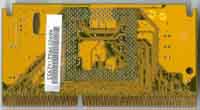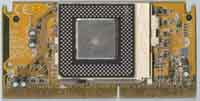Multiprocessor Systems: Dual Celerons
by Anand Lal Shimpi on March 18, 1999 9:23 PM EST- Posted in
- CPUs
The Socket-370 Celeron: a no-go
It was obvious, from the success of the original Dual Slot-1 Celeron project, that Intel had not included an incredible level of protection from running the Celeron processor in a dual processor configuration (4+ slot-1 processor configurations are not possible), and if one were to successfully implement a dual Celeron 300 configuration, clocked at 450MHz, you would theoretically have a dual 450MHz "high-end" workstation at a cost lower than a single Pentium II 450. The problem here was that overclocking two Celeron 300As to 450MHz was considerably easier than manipulating the processors to support operation in a multiprocessor configuration.
Intel originally chose to disable multiprocessor support on the Celeron line of processors as an attempt to more distinctly separate their processor brands. If the Pentium II was supposed to be the high-end flagship, and the low-end Celeron solution was allowed to run in dual processor workstations, customers would begin to wonder why they were spending a premium on the dual processor Pentium II systems when the Celeron could do the same thing. Most AnandTech readers already know that the Celeron 300A, when overclocked to 450MHz, offered, at the time of its discovery, unparalleled performance for the price. However, for a graphics artist, software developer, or engineer, even a single Celeron running at 450MHz would be considered slow in comparison to a beefy dual processor system that most professionals of that sort are used to. Luckily for Intel, the Celeron was kept away from the graphics artists, software developers, and engineers who reluctantly shelled out the extra cash for dual processor Pentium II systems.
With the release of the Socket-370 Celeron, many wondered if a motherboard manufacturer would be bold enough to release a motherboard equipped with two Socket-370 CPU sockets as to encourage more experimentation with dual processor Socket-370 Celeron solutions. The rumors of the possibility quickly died out, and the idea of a dual processor Celeron system remained out of the reach of everyone but those with the skill and the courage to attempt the basic dissection inspired by Kawada's method.

Celeron Processors & Cards Provided by Azzo Computers
A New Hope
| Walking hand in hand with the Socket-7esque PPGA Celeron processors were a group of seemingly useless Socket-370 to Slot-1 adapter cards that offered little more than a new way to spend $20 in the eyes of most users. | |
| By producing a Socket-370 Celeron to plug in to a board which then plugged in to a Slot-1 motherboard, manufacturers hoped to target system integrators looking for a guaranteed upgrade path from any current investment while keeping costs low. No one ever expected the "SlotKet" (a term coined by ABIT, the product name of their own Socket-370 to Slot-1 adapter) to be as useful as a product as it was soon to become. | |
| Needless to say, Kawada was back at it, this time with the help of some analysis provided by a Mr. Christopher Kuperman, he managed to produce an effective method for modifying a Socket-370 to Slot-1 adapter to allow for dual processor operation of a PPGA Celeron installed on the card, without even so much as touching the chip itself. |  Click to Enlarge |
| This way, instead of endangering the processor itself, you'll be risking a $20 investment in the adapter card if you happen to mess up during the modification process. At the same time, the adapter modification doesn't even require any physical modification to the adapter, rather a simple connection that even the most novice of users can get the hang of after a little practice. | |
How is it done? AnandTech took a look at the process, and attempted to simplify it as much as possible, so without further ado, here is a step-by-step guide to modifying a Socket-370 to Slot-1 adapter for use in a dual processor configuration.











0 Comments
View All Comments